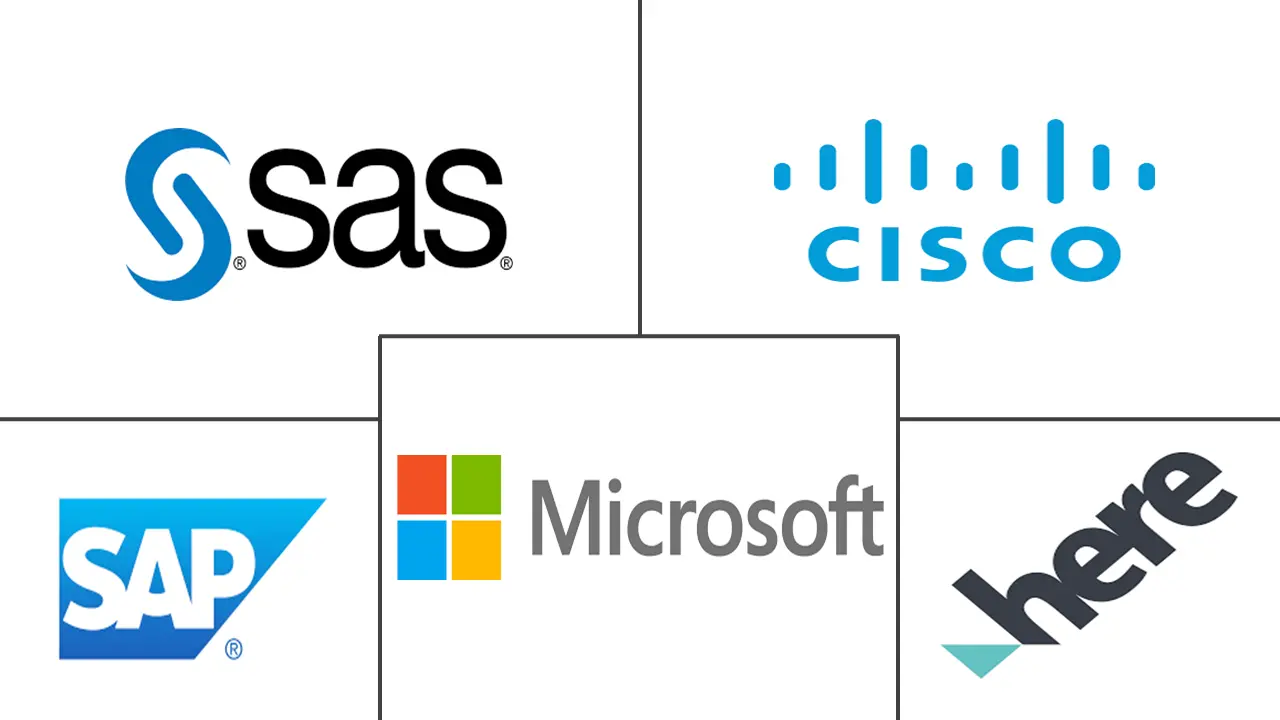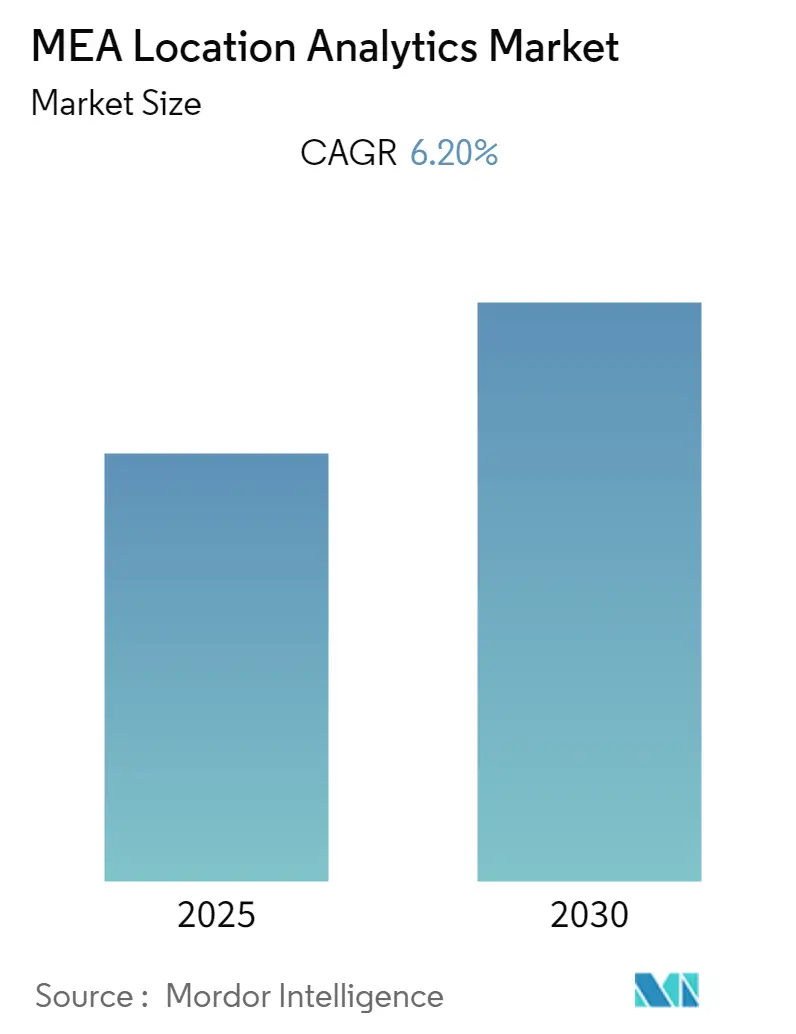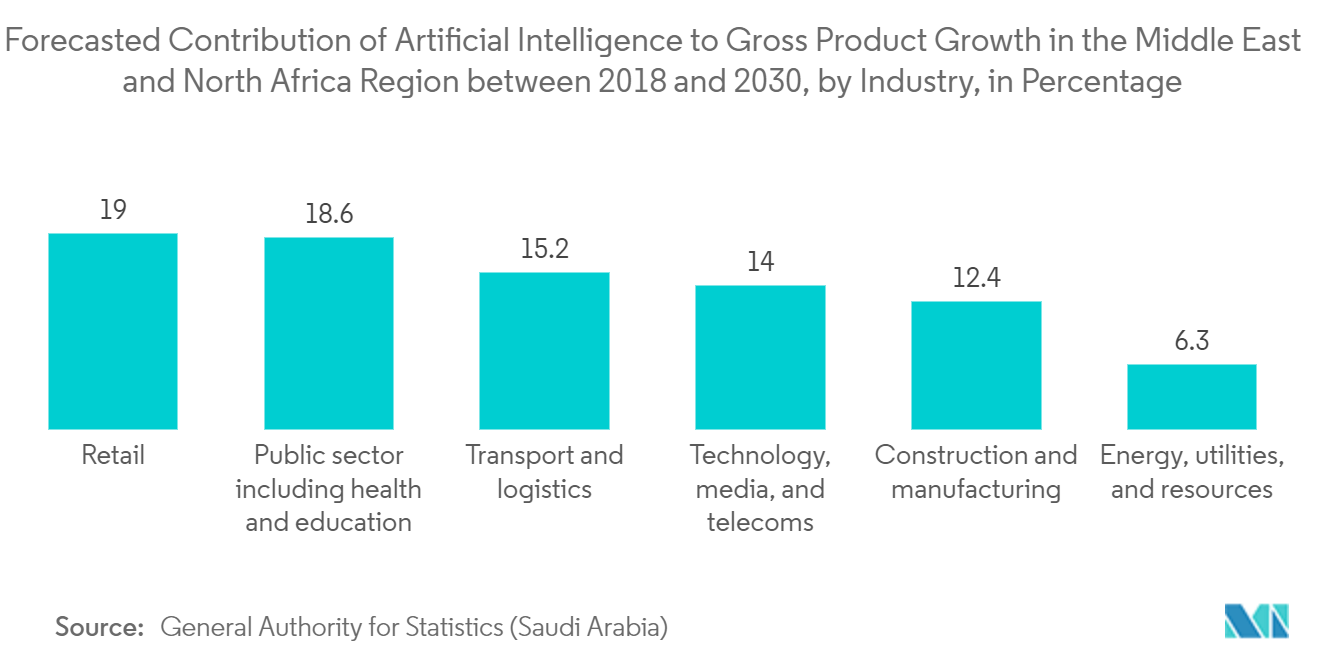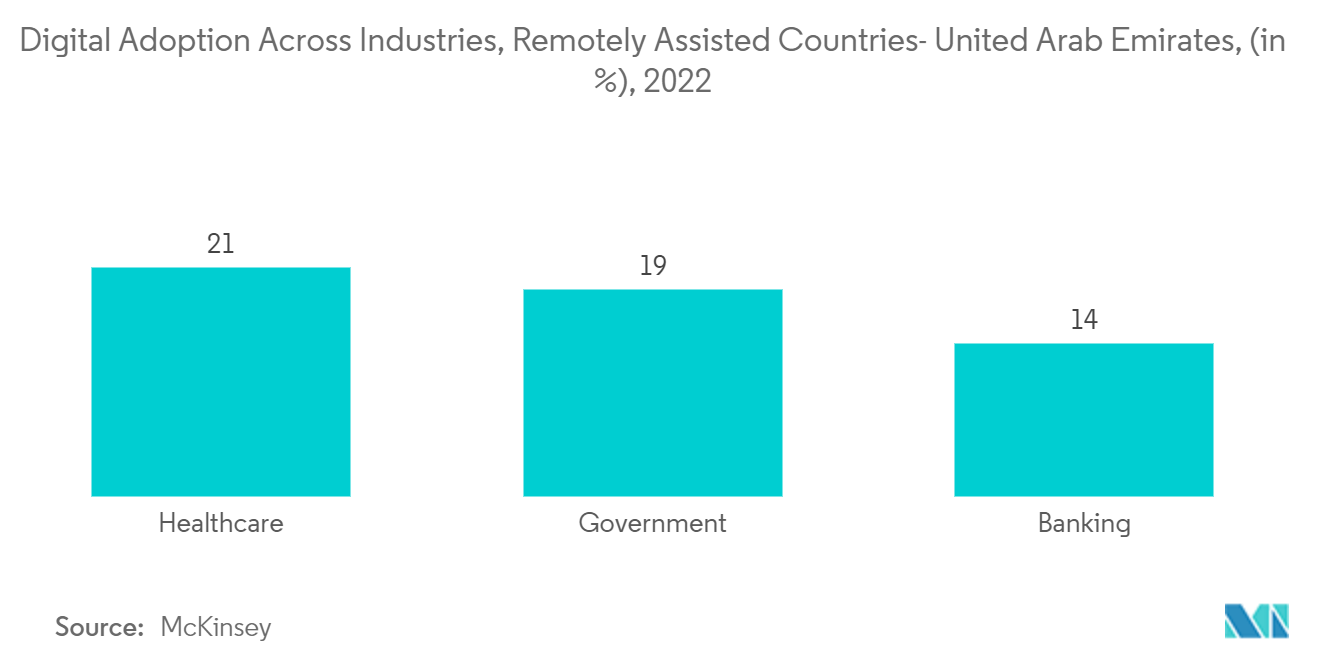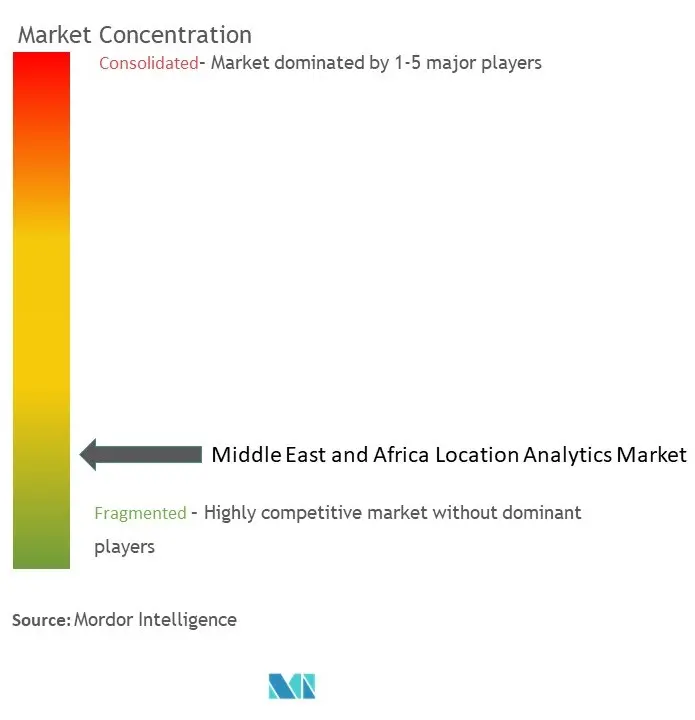Middle East & Africa Location Analytics Market Analysis
The MEA Location Analytics Market is expected to register a CAGR of 6.2% during the forecast period.
- The primary factors driving the growth of the market are the increased use of advanced location intelligence technologies such as Geographic Information System (GIS), Global Positioning System (GPS), and Remote Sensing (RS), as well as technological advancements in business intelligence and geospatial analytical tools, due to the rapid incorporation of location-based mapping technology in business intelligence systems and growing applications of location analytics in disaster management.
- Moreover, emerging technologies are expected to significantly drive the location analytics industry's growth in the coming years. 5G, artificial intelligence (AI), the Internet of Things (IoT), Big Data, and connected sensor devices are advanced technologies that have enabled real-time location data analytics for improved business performance.
- For comprehensive corporate planning, location analytics becomes a powerful analytical tool. New insights are produced by fusing location data with conventional relational data and data from reliable third parties. The Middle East & Africa retail market is starting to focus heavily on location analytics. Every time a customer or consumer enters the store following the last purchase till they leave, a piece of user data is created, and this number of merchants opens up daily.
- Smartphone adoption is exceptionally high in several nations, including the United Arab Emirates and Saudi Arabia. The location analytics market in this area is therefore anticipated to expand quickly. Wi-Fi Location Analysis Systems have been developed due to the expansion of all customer-facing sectors. Due to the system's open communication channels, customers can connect via Wi-Fi in their location, such as shopping malls.
- Consumer privacy considerations are essential when processing location data because numerous regulatory restrictions may make it impossible to get location data without the user's consent. Some geospatial analytics solutions require acquiring necessary location data, which some users may object to if they are concerned about the security of their location-based data.
- Due to the growing usage of location intelligence or analytics to better understand the effects of COVID-19 on consumer behavior and the economy, the COVID-19 outbreak does not affect the expansion of the location analytics business.
Middle East & Africa Location Analytics Market Trends
Rise of Technological Advances in Various Applications to Witness the Growth
- African and Middle Eastern nations have seen increasing adoption of modern technologies. There are now many connections in the region thanks to the recent and rapid digitization of areas like Saudi Arabia and the United Arab Emirates.
- End-user enterprises in more significant numbers are adopting artificial intelligence to boost productivity, create economic benefits, and raise security standards. Several government efforts are altering the industrial sector's dynamics and influencing the geography of essential nations like the United Arab Emirates. and Saudi Arabia.
- A better flow of structured and unstructured data emerged in this area during the Big Data era, along with a growth in the volume of real-time spatial data produced by big data, social networks, the Internet of Things, and other interactive media.
- Several regional governments have created long-term strategies to employ AI and ML to boost the economy, increase workforce productivity, and increase government flexibility. When the UAE government unveiled its Artificial Intelligence Strategy, it made clear how dependent it was on numerous infrastructure, industry, and service efforts utilizing AI.
- Currently, the government directly supports AI projects. Still, shortly, regional enterprises will establish their own AI departments and more substantial institutional and practical regulatory frameworks to promote private sector investment. These trends support the economies of Africa and the Middle East, accelerating the region's digitization.
Saudi Arabia to Hold the Largest Market Share
- Saudi Arabia has a multi-level, multi-faceted program that covers ecosystem development, investment, policy and regulation, research and innovation, and technology. As a result, the nation will become a hub for artificial intelligence and big data globally and one of the top data-driven economies in the world.
- With a focus on meeting Saudi Arabia's urgent needs by 2025, notably the nation's strategic development goal, Vision 2030, the national policy on data and AI will be implemented in stages.
- Developments in high-performance cloud computing, ubiquitous high-speed connection, new sensor networks, sensor platforms, geospatial analytics, and autonomous intelligent machines have also fueled the move toward a more machine-centric area.
- The market in Saudi Arabia already features some of the significant global e-commerce businesses, such as Amazon, eBay, and AllExpress from the Alibaba Group. It is projected that competition will increase when new players enter the e-trade market.
Middle East & Africa Location Analytics Industry Overview
The Middle East & African location analytics market is fragmented with Major industry giants like Cisco, Oracle Corporation, SAP SE, Systems, Microsoft Corporationand SAS Institute, Inc. present. These players are working hard to continually invest in and develop innovative location analytics technologies to benefit the region's infrastructure, retail, and corporate growth.
- September 2022 - SAS Viya analytics platform is now available in the Microsoft Azure Marketplace with the click of a button on a pay-as-you-go basis. Full-featured SAS Viya on Microsoft Azure equips customers worldwide with access to essential data exploration, machine learning, and model deployment analytics. It's available in many translated languages and includes an extensive in-app learning center to support immediate onboarding and long-term success.
- November 2022 - IBM has announced new software to assist enterprises in breaking down data and analytics silos to make data-driven decisions quickly and navigate unpredictable disruptions. IBM Business Analytics Enterprise is a suite of business intelligence planning, budgeting, reporting, forecasting, and dashboard capabilities that provides users with a comprehensive view of data sources across their entire organization.
- Furthermore, along with IBM Planning Analytics with Watson and IBM Cognos Analytics with Watson, this suite includes a new IBM Analytics Content Hub, which streamlines how users discover and access analytics and planning tools from multiple vendors in a single, personalized dashboard view.
Middle East & Africa Location Analytics Market Leaders
-
SAS Institute Inc
-
SAP SE
-
Cisco Systems
-
HERE
-
Microsoft Corporation
- *Disclaimer: Major Players sorted in no particular order
Middle East & Africa Location Analytics Market News
- October 2022 - Oracle Fusion Analytics now has additional CX, ERP, HCM, and SCM analytics capabilities. Decision-makers can now access a prebuilt library of more than 2,000 KPIs, dashboards, and reports that follow best practices for assessing performance about long-term objectives.
- Additionally, Oracle Analytics Cloud's most recent updates aim to increase business users' productivity by reducing their dependency on IT while allowing them to take advantage of selected data assets produced by IT, including the centralized semantic model. Data analysis has been made more accessible by new and improved composite visualizations. AI/ML advancements have expanded the ML capabilities in Oracle Analytics Cloud to include other cognitive services like AI Vision, allowing visual data processing.
- May 2022 - SAS' cloud-first portfolio soars cloud-first industry solutions. The analytics and AI leader's cloud-first approach eases customers' digital transformations; now, the company portfolio is to be cloud-native and cloud-portable so customers can accelerate their move to the cloud and expand their use of analytics, machine learning, and AI.
Middle East & Africa Location Analytics Industry Segmentation
Location analytics involves collecting and managing customer location data, enriching it with other data sources, and analyzing contextual information to inform optimized customer behavior, decisions, and experiences.
The Middle East & African Location Analytics Market is Segmented by Location (Outdoor and Indoor), Deployment Model (On-premise, On-demand), Application (Remote Monitoring, Asset Management, Facility Management), Component (Software, Services), Verticals (Retail, Manufacturing, Healthcare, Government, Energy and Power, Other Verticals) and Country (United Arab Emirates, Saudi Arabia, Israel). The market sizes and forecasts are provided in terms of value (USD million) for all the above segments.
| Location | Outdoor |
| Indoor | |
| Deployment Model | On-premise |
| On-demand | |
| Application | Remote Monitoring |
| Asset Management | |
| Facility Management | |
| Component | Software |
| Services | |
| Verticals | Retail |
| Manufacturing | |
| Healthcare | |
| Government | |
| Energy and Power | |
| Other Verticals | |
| Country | United Arab Emirates |
| Saudi Arabia | |
| Israel | |
| Other Countries |
Middle East & Africa Location Analytics Market Research FAQs
What is the current MEA Location Analytics Market size?
The MEA Location Analytics Market is projected to register a CAGR of 6.2% during the forecast period (2025-2030)
Who are the key players in MEA Location Analytics Market?
SAS Institute Inc, SAP SE, Cisco Systems, HERE and Microsoft Corporation are the major companies operating in the MEA Location Analytics Market.
What years does this MEA Location Analytics Market cover?
The report covers the MEA Location Analytics Market historical market size for years: 2019, 2020, 2021, 2022, 2023 and 2024. The report also forecasts the MEA Location Analytics Market size for years: 2025, 2026, 2027, 2028, 2029 and 2030.
Our Best Selling Reports
MEA Location Analytics Industry Report
Statistics for the 2025 MEA Location Analytics market share, size and revenue growth rate, created by Mordor Intelligence™ Industry Reports. MEA Location Analytics analysis includes a market forecast outlook for 2025 to 2030 and historical overview. Get a sample of this industry analysis as a free report PDF download.

